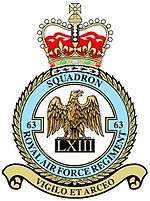Queen's Colour Squadron
The Queen's Colour Squadron is the unit of the Royal Air Force charged with the safe-keeping of the Queen's Colour for the Royal Air Force in the United Kingdom. Since its formation, it has been manned exclusively by officers and men of the RAF Regiment. It also has a secondary operational role as 63 Squadron RAF Regiment, a Regiment Field Squadron (RFS), responsible for the defence of RAF and other assets on the ground from enemy forces.
| The Queen's Colour Squadron, RAF (No. 63 Squadron, RAF Regiment) | |
|---|---|
 | |
| Active | 1960 - present |
| Country | |
| Branch | |
| Type | Air Force Infantry |
| Role | Public Duties Ground Defence |
| Size | 1 Squadron |
| Part of | RAF Air Command |
| Garrison/HQ | RAF Northolt |
| Motto(s) | Vigilo et Arceo (Latin: "I watch and ward")[1] |
| March | Royal Air Force March Past |
In its ceremonial role, the squadron is responsible for representing the Royal Air Force at various significant occasions. The unit has mounted the guard at Buckingham Palace, Windsor Castle and The Tower of London on several occasions, and has formed guards of honour for various visiting heads of state at Heathrow Airport, near its former base of RAF Uxbridge and its current base of RAF Northolt. The Squadron also handled the coffin of Diana, Princess of Wales on the return of her body to RAF Northolt following her death in Paris in 1997.[2]
The Queen's Colour Squadron of the RAF
The Royal Air Force had a ceremonial drill unit based at the Royal Air Force Depot at Uxbridge in Middlesex since the early 1920s. In 1960, the RAF Drill Unit was charged with the task of guarding and escorting the Queen's Colour of the Royal Air Force in the United Kingdom, and renamed the Queen's Colour Squadron. It was a pure ceremonial unit for 30 years, providing the sole escort to the colour, and famed for its displays of exhibition drill, which are performed without a single word of command. However, the Options for Change reforms led to the squadron being given an operational role as a field squadron in addition to its ceremonial role. For this, it was given the 'number plate' of No 63 Squadron, being renamed The Queen's Colour Squadron RAF (No 63 Squadron RAF Regiment).
No 63 Squadron RAF Regiment
No 63 Squadron was formed as a light anti-aircraft squadron in 1943, a role it served in for the duration of the Second World War. In 1946, while serving in Berlin, the squadron's role was changed, becoming a field squadron. It remained in this role until 1972, when it was planned to become the first RAF Regiment squadron to be equipped with the Rapier SAM, returning to the air defence role. Two unexpected tours in Northern Ireland meant that it was 1974 before the squadron converted. Following this, it was deployed in RAF Germany until 1992, when, with the gradual withdrawal of the RAF from mainland Europe, the squadron was disbanded. Whilst at Gutersloh, 63 Sqn RAF Regt was deployed, as part of 5 Brigade to the Falkland Islands during the conflict there. They landed at San Carlos on 29 May - 1 June, deployed immediately and remained there until being redeployed to Stanley after the conflict ceased.
63 RAF Regiment deployed to the invasion of Iraq in 2003 as an RFS to Basra Air Station, providing force protection to the air base and the RAF air assets located there.
References
- Pine, L.G. (1983). A dictionary of mottoes (1st publish. ed.). London [u.a.]: Routledge & Kegan Paul. p. 253. ISBN 0-7100-9339-X.
- The RAF Regiment - 63 Sqn RAF Regt History
External links
| Wikimedia Commons has media related to Queen's Colour Squadron. |
